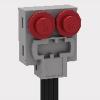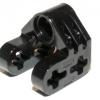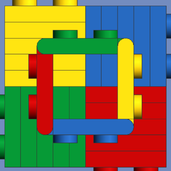Search the Community
Showing results for tags 'gears'.
Found 35 results
-

Help And Ideas Needed For Completing My Car
NickGratian posted a topic in LEGO Technic, Mindstorms, Model Team and Scale Modeling
I need suggestion with my car. I have images below of what I have so far. A few questions. What springs should I use. Hard or soft? What wheels or tires? And I need ideas on how to complete it. So far my axle has working steering and a driveshaft connected. I don't know what to do next as I am a new technic builder. If any more information or pictures are needed please tell me :) Images: http://imgur.com/a/QbhXw- 2 replies
-
- Suspension
- Wheels
-
(and 7 more)
Tagged with:
-

[HELP] 9396 - Rotor Friction
JGW3000 posted a topic in LEGO Technic, Mindstorms, Model Team and Scale Modeling
I have not been happy with the performance of my 9396 for a long time, so I am in the process of rebuilding it. The issue is that both the manual and motor-driven operation of the blades are sluggish and involves seemingly high torque, perhaps due to the large number of gears in the drive train, resulting in very slow turning blades. After completing about 82 steps in the rebuild, I got to a place in the build in which I can turn the blades with the hand knob, and again there seemed to be a lot of binding and "stiction" of the gears, which I traced to the gear directly driving the turntable being the primary trouble maker, highlighted as lime-colored in the LDD image. Loosening the build at this location, by forcing the two DSG11L beams slightly apart, resolves the issue, but is not a permanent solution as these will be tightly locked in place once the build is done. Does anyone else have similar issues, or suggestions to fix?- 7 replies
-
- 9396
- helicopter
-
(and 1 more)
Tagged with:
-
Hi guys, I have been trying to make some trains (generally diesel) and a problem that I have always found is powering. for a steam locomotive this is usually pretty simple because of the lack of articulation but wel, bogies are articulated and motors are mounted in the build itself. my question was, how does gearing react to this? and what is the handiest for compact solutions? vertical or horizontal? with vertical you get this: lego 6L train bogie by alterlegotechnic, on Flickr how could something like this be used in a locomotive? would the motor stick loosely in the chassis and what about a vertical motor like this (http://www.brickshel...16/cam06194.jpg) will there happen something in corners? like that the would go faster or some? and with Horizontal you get this Iowa Pacific SLRG 515/518 Mechanics by wildchicken_13, on Flickr how can gearing do this? i mean the rotating bogie, what happens to the gears in it? obviously could 2 M motors be needed for a small train (around 4 cars) or will it fail? I heard something about a V2 receiver? I have a V1 (I think) and that a normal one won't be able to give enough power to both? What is better? XL or M? when will a XL be needed? so in one sentence: vertical or horizontal? what happens to gearing and what is easier when using normal motors?
-

Lego axle variable velocity.
system posted a topic in LEGO Technic, Mindstorms, Model Team and Scale Modeling
Here are couple videos shows how to make velocity that varies, but remains constant over longer time. Very simple setup. Rotation with intervals. There is small chance that gears stuck. A-axle connected to motor and rotated with constant speed. B-axle connected through chain. Part time of cycle rotates faster, part time - slower. Both axles do full cycle in same amount of time. In both cases i attached axle to a gear in non-standard way. Attaching axle by different angle (but same place) will move center of rotation closer to gear side by 1 mm. You could place axle-pin to that place to fixate another axle in one of 4 holes of that gear. This gives another alternative for speed and position The only problem - I haw no idea where to use this approach :D So let me know if you used it anywhere. -
L'Supervivere Over the course of several years during the great industrial age, this mechanical suit was created by the lesser-known Professor Stewart Phoenix out of disused parts scavenged from various scrapheaps and abandoned factories around the outskirts of Victorian London, hence L'Supervivere's rather cobbled together and unusually complex appearance. The original and sole purpose of L'Supervivere was to be used by Professor Stewart Phoenix to protect his family and his estate, Phoenix Manor, from destruction, but over the years this technical monstrosity was also used for several other suitably vital causes, such as fixing leaks in the Manor's roof and rescuing cats from trees. The most notable alternative use of L'Supervivere was during a lengthy voyage abroad, in which it was used to navigate the treacherous rainforests of the Amazon and defend a party of explorers (including Professor Stewart Phoenix himself) against any threats they may have encountered. At the end of Professor Stewart Phoenix's long and fruitful life, he proclaimed in his last will and testament that L'Supervivere would be passed down to his eldest and only son, Dr Joseph Phoenix, on the sole condition that it mustn't be used for any type of criminal activity and that at the end of his life, he should also pass on L'Supervivere to his eldest son, and that this son should pass it on to HIS eldest son, and so on until what is only described within Professor Stewart Phoenix's will as "The end of all days", but so far no-one has been able to fully understand the meaning behind this choice of words. Mysteriously, after being passed down through several generations L'Supervivere and the Phoenix bloodline completely disappeared from public view in the early 1920s. It is still rumored that L'Supervivere still exists in its original form to this day, but the location of the suit itself and it's rightful owner is currently not known... More images on my Flickr. Enjoy!
-
Just another idea I got while making the LDD animating tutorial. Might be usefull, but generally its shows the hidden capabilities of LDD related to phsyics. Download the LXF here: http://www.bricksafe...gears/gears.lxf
- 27 replies
-
- gears
- hinge tool
-
(and 1 more)
Tagged with:
-

Design issue, help needed fitting the LAST PIECE [pics available]
brigadier90 posted a topic in Digital LEGO: Tools, Techniques, and Projects
Hey guys, Ive designed in my lab the following construct, which i found in a book: I am trying to use this construct as part of a manual i am making in LDD. However in LDD, when i try to place the final piece, which is the bevel gear Z20, it doesnt allow me. Please see image below: Any idea why this perfectly physcally feasable construct is impossible to build in LDD? PLEASE HELP Thank you- 6 replies
-
- design problem
- fitting issues
-
(and 4 more)
Tagged with:
-
.thumb.jpg.2335d10c31c9ffa7029728589340e12f.jpg)
Gears, most wanted
efferman posted a topic in LEGO Technic, Mindstorms, Model Team and Scale Modeling
because myself is actually in sickness to make some gears, which one would you like to have or, for purists, only to see? planetary gears, torsen diffs or worms which can fit on 12 and 20 tooth gears? anything else interesting in your mind? -

Measuring Power Loss in Gear Trains
Hrafn posted a topic in LEGO Technic, Mindstorms, Model Team and Scale Modeling
Has anyone attempted to measure the power loss from gearing motors up or down? What I'd really like to find is something like Philo's excellent work on motor specifications, batteries, tire traction, and so forth. Ideally it would compare all common pairs of gears (8/8, 16/16, 12/20, 8/24, 8/40, etc.) for at least a couple of motors.- 20 replies
-
- gears
- transmissions
-
(and 2 more)
Tagged with:
-
Hi I am working on gear pairs meshed directly together, in a 2 by 2 arrangement. Two gears on each of the two axles - However one gear is an idler gear which is driven by the other gears instead of with the same rotation speed as the motor. However I'm not sure if the ratio for the idler gear will be 1:1 since there is two 16 tooth gear gears in either example I don't think it is 1:1 though it should be what the other two gears are, so say 3:1 or 1.6:1 but I'm unsure as it's hard to tell. The yellow axle joiner goes to the motor, I'm using a differential to replicate a single 24 tooth idler in the first image. Obviously the dark grey gears are the idlers. Any ideas what it could be. More gears can be used with studed beams and plates such as 16 tooth +12 tooth or 20 + 20 or 16 + 20 etc. Regards, S




